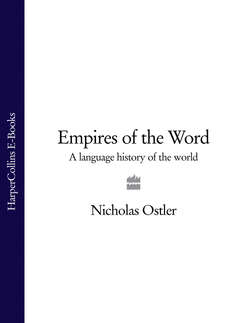Читать книгу Empires of the Word: A Language History of the World - Nicholas Ostler - Страница 25
A Middle Eastern inheritance: The glamour of the desert nomad
ОглавлениеThe present-day globalised world is full of Arabic. It is the language that would-be Islamist revolutionaries in Europe and the USA feel they have to learn to give authenticity to their struggle; and its ironic similarity to Hebrew, newly revived in the land of Canaan, is a standing reminder of how the bitterest conflicts set long-lost cousins at each other’s throats: salām contends against š∂lōm, but the common meaning, ‘peace’, continues to elude them. Meanwhile the classical language is still intoned every day in Muslim prayer, and broadcast to an audience of well over 200 million souls, all of whom think when they converse, in their very different ways, that they are talking Arabic, ‘arabīya.
The language tradition of large-scale, unitary Semitic languages to which they are all heirs goes back demonstrably for five thousand years. In that time, there has been opportunity for a lot of innovations; the world has seen in their tradition the first adoption of a foreign language as a classic model for literature, the first system of writing with multilingual application, the first lingua franca of international diplomacy, the first archival libraries, the first alphabetic scripts, the first spread of language through trading colonies, the first substitution of one language for another without breakdown of a single literate tradition, the first use of a language as the talisman of a minority religious sect, the first designation of the written record of a particular language as the unchangeable word of God.
That is a fair record of firsts for a single tradition, even if its dominant language has twice been replaced, or, to put it perhaps better, renewed. We shall consider elsewhere the significance of all these examples in the general pattern of the development of human language systems.
An appropriate final reflection here might be to consider whether there is any distinctive continuity of character in this ancient tradition. Is there something about Arabic which it shares with Aramaic and Akkadian? Or have so many innovations, on the way through remote antiquity and the Middle Ages into the modern world, in effect revised away any common core?
Fernand Braudel saw in the total success of Muslim advance, so sudden and apparently so inexplicable, the natural reassertion of the Near Eastern tradition, after a Greek and Roman interruption of a thousand years.84 He did see the Arabic language as the surest proof that countries are truly part of Muslim civilisation,85 yet the examples he gives of continuity in Near Eastern civilisation—dress, food, domestic architecture, even monotheistic faith—have nothing to do with language.86
At the most obvious level, the values promoted in Islam are the polar opposite of what their great imperialist predecessors the Assyrians embraced. The Muslims put forward their unique conception of God as a reason to accept their rule, emphasising all the while His infinite compassion. The Assyrian armies rolled over their neighbours to prove the greater might of their kings, and demonstrated their power through orgies of ruthlessness. Their gods followed, and if many chose to worship them, this was purely an acknowledgement of the greater power of all they stood for, an act of prudence and diplomacy, not the acceptance of a revelation or an act of sincere submission.
The Arabs going into battle for Islam can be seen in fact as an alloy of three very different preceding traditions among their fellow-speakers of Semitic languages: the abstract theology of the Jews, the embracing inclusiveness of the Aramaic Christians, and the military momentum of the Assyrians. Indeed, if one includes their propensity for long-distance navigation and speculative trading, they can also be ranged with the Phoenicians.
But there is one thing in the cultural background which does unite all the Semites, of whatever religion or desired level of opulence. However successful their cities, however developed their religions and philosophies, they never escaped the memory that they had all arisen from desert nomads. Arabic was the language of nomads, and Islam was founded by nomad aggression from Arabia. Aramaic penetrated the Assyrian and Babylonian empires, and so became established, through nomads spreading from Aram. The Hebrews and Phoenicians developed their cities and their cultures when Habiru nomads had finally settled down in the land of Canaan; explicitly, the Torah talks of the children of Israel wandering through the wilderness of Sinai for forty years. And the Akkadians might never have taken over from Sumer without the incursions of those little-known nomads of the west, the Amorites. Ultimately, surely, it must have been nomads who brought the Semitic languages in prehistoric times out of Africa and into the Fertile Crescent.
Nomads may be hard to find in the modern Semitic world. But aspects of nomadism are still central to the unsolved problems of the Arabs: the homelessness of the Palestinians, the moral queasiness about the unearned riches welling up from the desert wastes of Arabia, the wild men of al-Qa’eda in self-imposed exile while they plan destruction for the iniquitous cities. In all this, speakers of Arabic are very true to their tradition. Indeed, the histories of Akkadian, Phoenician, Aramaic and Arabic are a five-thousand-year demonstration of the benefits of the desert—as a place to come in from.
